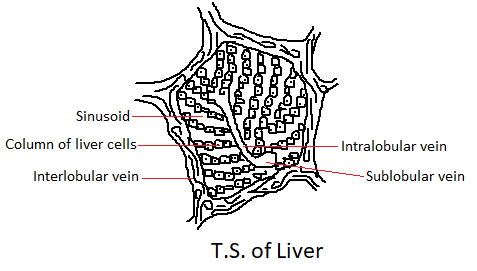
Answer
428.4k+ views
Hint: The liver is a dark-colored organ found in vertebrates only. It helps in the detoxification of various metabolites and produces biochemicals required for growth and digestion. It is located in the upper section of the abdomen and is wedge-shaped.
Complete answer: The liver is one of the vital organs present only in vertebrates. It is a dark reddish-brown organ having a wedge shape and is present in the upper section of the abdomen just below the diaphragm. It plays an important role in metabolism, growth, protein production, hormone production, etc. The liver is also termed as an accessory digestive organ. It produces bile which is an alkaline fluid consisting of cholesterol and bile acids. It helps in the breakdown of fats during digestion. Just under the liver lies a small pouch called the gallbladder. It helps in the storage of bile and transports it to the small intestine during digestion. The liver is made of highly specialized tissue that is made of hepatocytes. The two lobes of the liver have an unequal size and give a wedge shape to it. The blood vessels that supply the liver subdivide to form liver sinusoids. These sinusoids lead to lobules which are the functional units of the liver. Millions of hepatic cells make up these lobules.

The liver helps in detoxifying various bodily metabolites. Syntheses of various proteins and hormones necessary for digestion and growth occur in the liver. It removes toxic substances like xenobiotics and other harmful drugs.It helps in regulating the glycogen storage, production of hormones, and decomposition of red blood cells. Secretion of bile by the liver helps in the metabolism of fats.
The liver has a major role in the excretion of bilirubin. Bilirubin is a by-product of Red blood cell destruction. It is excreted along with bile. The liver is an expandable organ and thus stores large quantities of blood in its blood vessels.
Note: The liver is also involved in the storage of vitamin A, Vitamin K, iron, and vitamin D. Liver also contains many immunologically active cells. The liver also produces albumin. It is the most abundant protein found in blood serum. It has a major role in fatty acids and steroid hormone transport.
Complete answer: The liver is one of the vital organs present only in vertebrates. It is a dark reddish-brown organ having a wedge shape and is present in the upper section of the abdomen just below the diaphragm. It plays an important role in metabolism, growth, protein production, hormone production, etc. The liver is also termed as an accessory digestive organ. It produces bile which is an alkaline fluid consisting of cholesterol and bile acids. It helps in the breakdown of fats during digestion. Just under the liver lies a small pouch called the gallbladder. It helps in the storage of bile and transports it to the small intestine during digestion. The liver is made of highly specialized tissue that is made of hepatocytes. The two lobes of the liver have an unequal size and give a wedge shape to it. The blood vessels that supply the liver subdivide to form liver sinusoids. These sinusoids lead to lobules which are the functional units of the liver. Millions of hepatic cells make up these lobules.

The liver helps in detoxifying various bodily metabolites. Syntheses of various proteins and hormones necessary for digestion and growth occur in the liver. It removes toxic substances like xenobiotics and other harmful drugs.It helps in regulating the glycogen storage, production of hormones, and decomposition of red blood cells. Secretion of bile by the liver helps in the metabolism of fats.
The liver has a major role in the excretion of bilirubin. Bilirubin is a by-product of Red blood cell destruction. It is excreted along with bile. The liver is an expandable organ and thus stores large quantities of blood in its blood vessels.
Note: The liver is also involved in the storage of vitamin A, Vitamin K, iron, and vitamin D. Liver also contains many immunologically active cells. The liver also produces albumin. It is the most abundant protein found in blood serum. It has a major role in fatty acids and steroid hormone transport.
Recently Updated Pages
what is the correct chronological order of the following class 10 social science CBSE

Which of the following was not the actual cause for class 10 social science CBSE

Which of the following statements is not correct A class 10 social science CBSE

Which of the following leaders was not present in the class 10 social science CBSE

Garampani Sanctuary is located at A Diphu Assam B Gangtok class 10 social science CBSE

Which one of the following places is not covered by class 10 social science CBSE

Trending doubts
Harsha Charita was written by A Kalidasa B Vishakhadatta class 7 social science CBSE

Which are the Top 10 Largest Countries of the World?

Banabhatta wrote Harshavardhanas biography What is class 6 social science CBSE

Difference Between Plant Cell and Animal Cell

Fill the blanks with the suitable prepositions 1 The class 9 english CBSE

How do you graph the function fx 4x class 9 maths CBSE

The Equation xxx + 2 is Satisfied when x is Equal to Class 10 Maths

One Metric ton is equal to kg A 10000 B 1000 C 100 class 11 physics CBSE

Why is there a time difference of about 5 hours between class 10 social science CBSE



